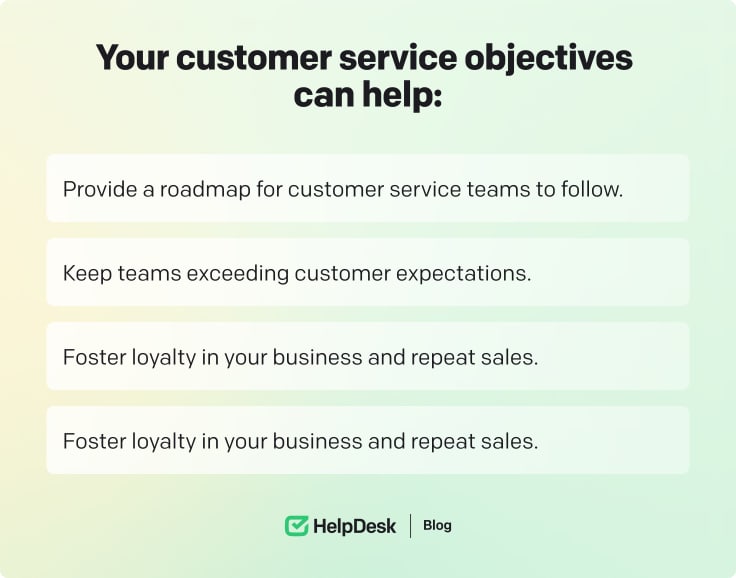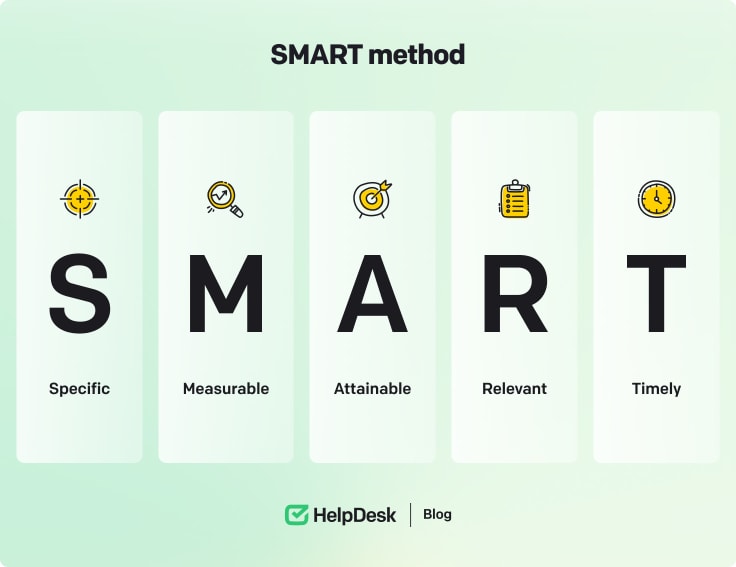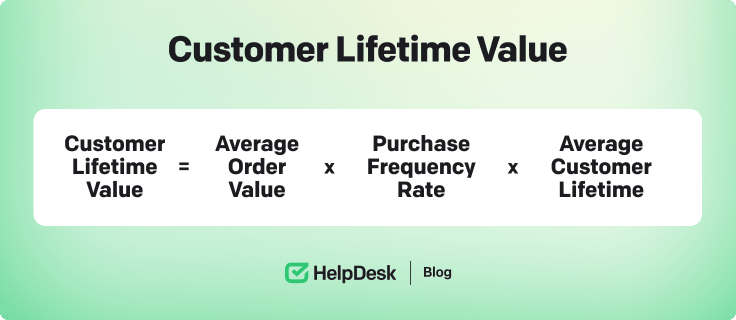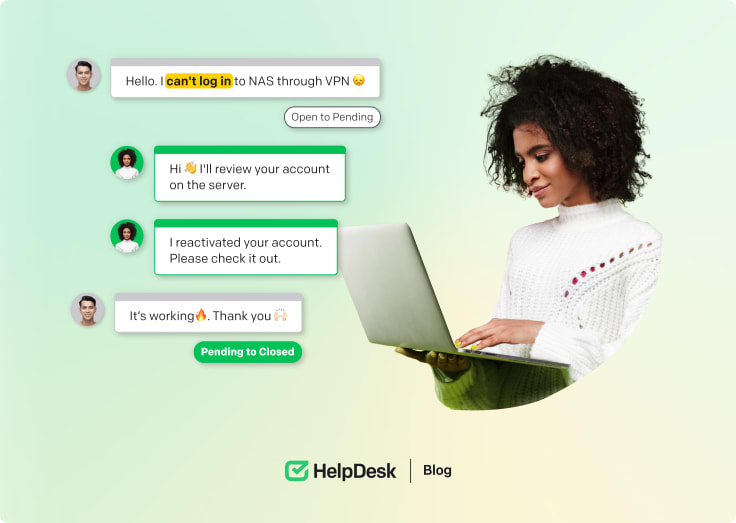Your customers are on a journey, and your business must meet customer service objectives. If you fall short on expectations, it can cause your company to suffer from:
-
Negative customer feedback reduces the chance that 92% of buyers will purchase (source).
-
Lost customer loyalty from buyers who expect you to know and meet their main customer service objective.
-
Unhappy customers who will be vocal about your business’s poor service.
Your customer journey must include setting customer service objectives based on your mission, values, and vision and understanding the job description.
If you don’t focus on customer relationships, it will hurt your sales. Consumers have more options than ever before, and if your customer service position is disjointed, it can lead to lower sales, lost potential customers, and fewer loyal customers.
I’ll outline how you can work to meet customer service objectives, improve customer satisfaction, and exceed expectations.
But where do you even start?
Understanding customer service goals
Your customer service objectives are measurable. Organizations must define what their goals are and how to measure them, such as:
-
95% satisfaction rate from surveys
-
4.7% star average on reviews
If you receive customer inquiries, you may want to measure how many calls are closed in 30 minutes, one hour, etc. Additionally, your customer service objective may be to make an immediate sale, and you must have key performance indicators (KPIs) to measure this target.
Customer service representatives are competitive and want to strive for the excellence your customers deserve, but they need a clear customer service objective to measure success or failure.
You can brainstorm your goals with customer service teams, but they must all refer to your business mission, vision, and values.
When your goals all refer back to the core of your business’s purpose, it leads to delivering excellent customer service consistently. Many companies stray from their original purpose and lose customers because the service they used to provide begins to decline.
There may be many reasons for this decline, such as a change in customer service team management or losing a leader who led the team to success.
Well-defined targets empower organizations to provide exceptional customer service, even if leaders leave.

Exceptional customer service starts within a business and relies on goals measured by customer interactions. A hiring manager needs to vet customer service reps properly, but success often falls on having the right objectives in place from the start.
Crafting and setting customer service objectives
Customer service operations need consistent objectives to guide them. If you don’t have objectives, how can you expect someone in a customer service position to reach your internal goals?
So, where do you begin when defining your objectives?
A good customer service often starts with a well-defined objective that aligns with the company’s goals.
If you’ve never had to create customer service objectives before, follow our guidelines below to help you brainstorm goals that will keep your customers happy:
Specific, measurable, achievable, relevant, and time-bound (SMART)
The world’s top companies use SMART goals. The idea is simple. Your goals need to be:
-
Specific.
-
Measurable.
-
Achievable.
-
Relevant.
-
Time-bound.
It’s not enough to say, “We want to do better.” Instead, you want to say, “By Q4, we want 50+ 5-star reviews from new customers.”
Judge your objective, including those in your customer service, against these SMART standards.

Objectives must be based on your mission, vision, and values
Goals should align with your business:
-
Mission.
-
Vision.
-
Value.
You’ll move closer to your business’s main mission when your goals follow these three elements.
Goals need to target customer segments
Your objectives must be tailored to the specific needs of each customer segment and based on any internal data you’ve compiled.
Once you have your goals in place, you need to:
-
Communicate the goals to all customer service representatives.
-
Review your objectives regularly.
-
Update your objectives to keep them relevant.
When creating an objective statement and defining your goals, tools like HelpDesk will empower you to keep all messages in one place. Stakeholders can easily see customer messages to stay on top of the primary concerns and resolve customer issues rapidly.
Be customer-oriented with HelpDesk. Join our free 14-day trial and enhance your customer service. 🚀
Essential customer service objectives
You know how to develop excellent objectives. Now, it’s time to define each one. A few of the essential customer service goals that are almost standard in the industry and will fit perfectly into every target market are:
Boost customer satisfaction
Customer dissatisfaction leads to lost business and a negative reputation. Your main goal — or one of them — should be to improve satisfaction through:
-
Customer service.
-
Feedback channels.
-
Refining your product or service.
If you keep customers happy with your customer service and what you’re selling them, you’ll be a success.
Want to learn more about customer feedback? 🧑🚀 Read our Learning Space lesson: How To Get Customer Feedback and Measure Satisfaction ☑️
Boost customer loyalty and retention
Customer retention is less expensive than landing new customers. You can have your team work on its communication skills and offer:
-
Reward-type programs.
-
Express service for repeat customers.
-
Customer retention team.
As your product and customer service improve, loyalty and retention will follow. Monitor your churn rate.
Minimize customer wait time
83% of consumers demand exceptional service, while others expect immediate service (source). Monitor your first response time and focus on reducing it as a primary customer service objective.
Promote self-service
People want answers and are willing to look for them on FAQ pages, knowledge bases, AI chatbots, and even how-to videos. To reduce wait times and alleviate the stress on support teams, create a self-service option for customer service.
Boost productivity
Integrate productivity-boosting tools to your customer service team, including:
-
Support dashboards.
-
Scannable knowledge bases.
-
Automated systems.
Reducing errors and delays keeps your support team lean and working at full capacity.
Provide regular training
Each customer service representative you hire should undergo regular training on:
-
Customer service skills.
-
Maintaining strong interpersonal skills.
-
Company policies and procedures.
-
New products and services.
-
Common support tickets.
Business leaders need to work with the head of customer support to create practical training that keeps customers happy.
Efficient customer recovery
Every business has to deal with unsatisfied customers at some point. Your customer recovery process can transform negative reviews and resolve grievances.
Customer recovery starts with providing good customer service and understanding the customer’s pain points. Clear guidelines for addressing complaints will also ensure that agents handle these issues professionally and empathetically.
Deploy customer service management tools
The right tools can empower employees working in a customer service role and help your business achieve its objectives.
Some tools include:
-
Ticketing solutions to streamline, track, and manage customer support tasks.
-
Customer relationship management (CRM) solutions to manage communication and customer interaction.
-
A knowledge base to provide agents and customers with the information they need to solve problems.
Offer clear communication
Every customer service representative on your team should have excellent communication skills. To meet customer expectations and solve their problems, agents should excel at:
-
Listening attentively.
-
Being empathetic to customers.
-
Providing accurate and helpful information.
Agents should also communicate in a polite and friendly tone. Maintaining professionalism should be a top priority.
Maximize customer lifetime value (CLV)
Many businesses aim to increase their CLV. Employing strategies to meet customer needs and boost engagement can go a long way toward improving the number of satisfied customers and ensuring they become repeat customers.
Providing excellent customer service will encourage customers to continue doing business with you.

Fast issue resolution
It should be the goal of every business to resolve customer complaints quickly. Efforts should be focused on:
-
Reducing the time it takes to reach a customer service representative.
-
Ensuring customer problems are solved as efficiently as possible.
-
Improving your team’s problem-solving skills to help solve complex problems faster.
-
Streamlining workflow processes and leveraging technology to enhance the customer experience.
-
Providing customer support reps with the resources and tools they need to resolve issues.
React fast on customer issues with HelpDesk. Take advantage of HelpDesk's 14-day free trial to see how your case-tracking process will improve. 🚀

Boost revenue and reduce costs
Most businesses want to boost their revenue while reducing costs. However, your strategies should maintain the quality of your customer service.
Often, these objectives can be achieved by:
-
Optimizing workflows to improve productivity and performance.
-
Leveraging technology, especially automation, to streamline operations and solve customer problems faster.
-
Developing targeted campaigns to upsell and cross-sell products and optimize revenue generation.
Enhance brand reputation
Many businesses overlook the importance of reputation and its role in attracting new customers. Some brands have a reputation for providing an excellent customer experience, high-quality products, and top-tier support for their products or services. Their reputation for excellence is what brings new customers to their doors.
Improving your brand’s reputation starts with providing exceptional customer service, but this should be supported with:
-
Clear communication.
-
Proactive reputation management.
-
Rectifying issues and accepting responsibility when you’re wrong.
Extending a gesture of goodwill can go a long way in changing a customer’s opinion of your brand.
Cultivating a customer-first culture and prioritizing quality will help your brand develop a positive reputation.
Foster customer advocacy
Customers want to feel valued and appreciated. You can achieve this goal by cultivating customer advocacy. Focus on building initiatives that acknowledge and incentivize loyal customers.
Over time, customer engagement will improve, and many loyal customers will transform into ambassadors who promote your brand.
Build strong customer relationships
Providing fast and effective service is essential, but ensuring that you’re building relationships with your customers is equally important.
An agent in a customer service role should have strong communication skills. Still, they should also be armed with the right tools to meet customer expectations and understand their needs. A customer-centric approach will help you build meaningful and lasting customer relationships.
You can also build strong customer relationships by:
-
Taking a proactive approach to fulfilling customer needs.
-
Implementing personalized communication strategies.
-
Employing feedback channels.
Learn how to build stronger customer relations. Start your journey today 🔥

Implementing and measuring customer service objectives
Defining and crafting your customer service objectives is just one step. The real challenge lies in implementing and measuring these objectives.
To succeed, you’ll need a clear plan and strategy.
Implementation will require:
-
Clear communication: Ensure your customer service team knows your objectives. Clear communication will help ensure your goals are met.
-
Thorough training: Whether your objective is to maximize customer lifetime value, minimize customer wait time, or improve customer satisfaction, you need a strategy to achieve your goals. And your team will need training to bring that strategy to life.
-
Feedback: Measuring your team’s performance and providing feedback will help ensure your training is practical and working towards reaching your goals.
But how can you determine whether your training and efforts are paying off? Make sure you have a framework in place to measure your results.
KPIs can help you understand whether you’re achieving your goals. While every organization is unique, some KPIs will be relevant to most businesses, including:
-
Customer satisfaction — does your team exceed customer expectations?
-
First response time — how quickly are you responding to customers when they reach out?
-
Resolution rate — are you solving customer pain points?
Sit down and analyze your objectives to define the KPIs that will be most relevant to your organization.
Along with defining and tracking your KPIs, you should regularly review and analyze your customer service metrics to ensure you meet your customer service objectives.
Your team can also be a valuable resource for measuring your progress and making improvements. Encourage them to use customer feedback to identify areas of improvement and make changes based on this feedback.
Training and development should be continuous and essential in ensuring your team has the knowledge and skills to meet your customer service objectives.
Summary
Crafting clear and impactful customer service objectives is vital for meeting and exceeding consumer expectations and ensuring a continually outstanding experience. It’s paramount to pinpoint the most crucial objectives that resonate with your business aspirations. It requires delving into your customers’ distinct needs, preferences, and pain points.
Once these pivotal objectives are defined, it’s equally important to establish a robust framework for monitoring and measuring the performance of your strategies over time. Through consistent evaluation and improvement, you can ensure that your customer service endeavors meet and evolve in line with changing consumer demands, ultimately fostering enduring customer satisfaction and loyalty.



